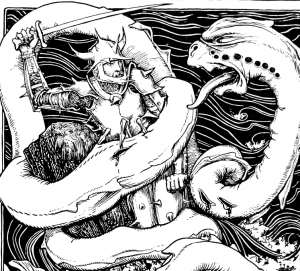Profiling Giants
Posted by: Nick Redfern on September 7th, 2013

In a new post at Mysterious Universe, Christy Gordon profiles five giant-sized critters. The article begins…
“Though cryptids like atmospheric beasts and sheepsquatch are fantastical creatures unlike any known animals, some cryptids are merely super-sized versions of existing species. Name an animal or insect and chances are good that someone, somewhere (or several people in numerous locations) claim enormous versions of the creature exist. With that in mind, here are five giant cryptids from around the world. Which do you find the most terrifying?”
About Nick Redfern
Punk music fan, Tennents Super and Carlsberg Special Brew beer fan, horror film fan, chocolate fan, like to wear black clothes, like to stay up late. Work as a writer.










So the insinuation is that Bigfoots are outlandish-sized country cousins of ourselves? Well… COULD BE, but I CERTAINLY could have done without that giant centipede! Thanks. Thanks A LOT!!
Looks like a sleepless night here.
OK, here’s the run down…
1. Giant Spiders. The largest spiders that exist today are as large as they can be due the reduced oxygen levels in the current atmosphere. Insects and spiders in fact all “bugs” do not have lungs and rely on air pressure and leg movement to circulate air into and out of the bodies. When truly giant insects and arachnids existed, in the Carboniferous Age, the oxygen content was much high than now and allowed these animals to attain great size…but not in present times due to the greatly reduced oxygen levels. Probably not.
2.Giant Freshwater Octopi. There are no freshwater octopi existing anywhere of any size. If one species could adapt itself to freshwater, it take large body of water to support it. Not impossible but, show me when you find one. Probably not. An old-time Oklahoma legend.
3. Giant Bats. The largest known bats are the Pteropus fruit bats with a wingspan of over four feet. Could they get bigger, yes but not much bigger because unlike birds, bats have heavy skulls and skeletons which curtails them from becoming true giants. Probably not.
4. Giant Centipedes…see Giant Spiders as the same criteria applies. The one pictured In the article is plenty big enough for me…
5. Giant Snakes. Definitely a possibility and perhaps the most likely as well. Giant Snakes have several things going for them. There were giant snakes in the relatively not to distant past and like most reptiles, snakes continue growing until death. 34 feet seems to be the longest accepted length for the largest snakes alive today. There certainly could be much longer individuals out there waiting to be discovered. A good possibility as there are no real conditions preventing it.
cryptokellie:
One question: isn’t it true that in the Carboniferous Age, carbon dioxide levels were much higher than at present also?
Not disagreeing with anything. It’s just I point I wanted to clear up for myself, mostly.
Actually, the CO2 levels were high at the beginning and dropped during the middle Carbonifeous and into the Permian where the levels continued to be low until the rise of levels in the end of the Jurassic into the Cretaceous when they fall again.
They have stayed somewhat level until modern times where they are surprisingly low compared to the past.
I did know that CO2 levels are comparatively low at present.
When compared to epochal levels throughout the Earth’s history, yes they are quite low. A slight up tick during Holocene but generally falling dramatically from the Jurassic/Cretaceous boundary to recent time, perhaps due to increases in solar activity.
If our Sun isn’t the overwhelming climactic driver, I cannot imagine what else people might imagine it is… if everything was at absolute zero, the entire Cosmos could not exist. There would be no stars. No stars, no heat. No heat, no climate.